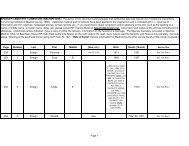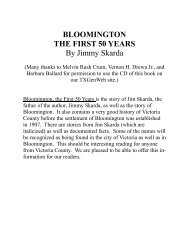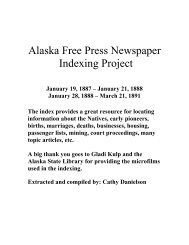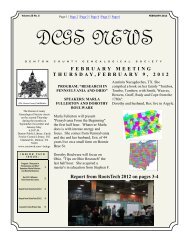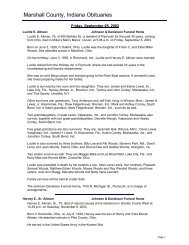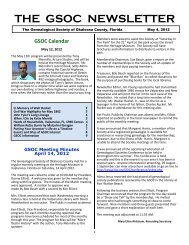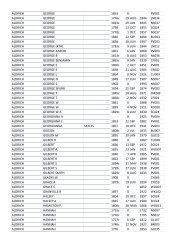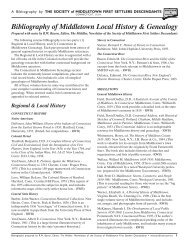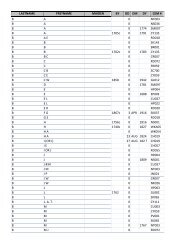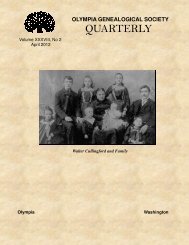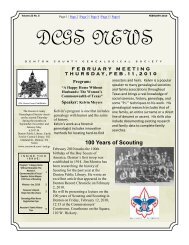Indian population in the United States and Alaska. 1910 - RootsWeb
Indian population in the United States and Alaska. 1910 - RootsWeb
Indian population in the United States and Alaska. 1910 - RootsWeb
Create successful ePaper yourself
Turn your PDF publications into a flip-book with our unique Google optimized e-Paper software.
The apportionment of congressional representation<br />
under <strong>the</strong> Constitution is made proportional to <strong>the</strong><br />
<strong>population</strong> of each state, "exclud<strong>in</strong>g <strong>Indian</strong>s not<br />
taxed." The status of <strong>the</strong> <strong>Indian</strong> <strong>in</strong> regard to tax-<br />
ation is <strong>the</strong>refore a matter of importance to Congress.<br />
One of <strong>the</strong> <strong>in</strong>quiries for which an answer was required<br />
concern<strong>in</strong>g each <strong>Indian</strong> enumerated on <strong>the</strong> special<br />
<strong>Indian</strong> schedule <strong>in</strong> <strong>1910</strong> was: Is this <strong>Indian</strong> taxed?<br />
It proved <strong>in</strong>advisable, however, <strong>in</strong> determ<strong>in</strong><strong>in</strong>g <strong>the</strong><br />
number of <strong>Indian</strong>s not taxed, to depend entirely upon<br />
<strong>the</strong> answers made on <strong>the</strong> special <strong>Indian</strong> schedule,<br />
because of <strong>the</strong> fact that many of <strong>the</strong> <strong>Indian</strong>s were<br />
<strong>in</strong>competent or possibly unwiU<strong>in</strong>g to give <strong>the</strong>ir own<br />
status, while <strong>the</strong> enumerators were unable to correct<br />
or supplement <strong>the</strong> <strong>in</strong>formation thus secured. The<br />
problem was not an easy one to settle, as it <strong>in</strong>volved<br />
not only questions of fact but also questions of law.<br />
For <strong>the</strong>se reasons special arrangements were made <strong>in</strong><br />
<strong>the</strong> bureau for <strong>the</strong> consideration of <strong>the</strong> problem <strong>in</strong> all<br />
its phases, utUiz<strong>in</strong>g all <strong>the</strong> data which might throw<br />
INDIANS TAXED AND NOT TAXED.<br />
light on <strong>the</strong> subject. In this work <strong>the</strong> Bureau of <strong>the</strong><br />
Census was also aided by <strong>the</strong> Office of <strong>Indian</strong> Affairs.<br />
The number of <strong>Indian</strong>s taxed <strong>and</strong> not taxed <strong>in</strong> <strong>the</strong><br />
<strong>United</strong> <strong>States</strong> <strong>in</strong> <strong>1910</strong>, as compared with 1900 <strong>and</strong> 1890,<br />
is shown, by states, <strong>in</strong> Table 110 on page 284. The<br />
proportion of <strong>Indian</strong>s taxed <strong>in</strong> <strong>1910</strong> <strong>and</strong> <strong>in</strong> 1890 is<br />
shown graphically <strong>in</strong> <strong>the</strong> maps on page 285.<br />
In <strong>1910</strong>, as shown by Table 110, <strong>the</strong> taxed <strong>Indian</strong>s<br />
numbered 193,811, <strong>and</strong> constituted nearly three-<br />
fourths ( 72.9 per cent) of <strong>the</strong> total <strong>Indian</strong> <strong>population</strong>,<br />
as compared with 58,806 <strong>in</strong> 1890, or less than onefourth<br />
(23.7 per cent) of all <strong>the</strong> <strong>Indian</strong>s enumerated<br />
at that census. Prior to 1890 no systematic attempt<br />
was made to enumerate aU <strong>Indian</strong>s, but <strong>in</strong> 1880 <strong>the</strong>re<br />
were 66,407 "civilized" <strong>Indian</strong>s reported; <strong>in</strong> 1870,<br />
25,731; <strong>and</strong> <strong>in</strong> 1860, 44,021. In a general way <strong>the</strong><br />
"civihzed" <strong>Indian</strong>s of <strong>the</strong> earher decades, mean<strong>in</strong>g<br />
those off reservations <strong>and</strong> found scattered among <strong>the</strong><br />
general <strong>population</strong>, may be considered synonymous<br />
with "taxed" <strong>Indian</strong>s of to-day.<br />
There were 33 states, besides <strong>the</strong> District of Colum-<br />
bia, <strong>in</strong> <strong>1910</strong>, <strong>in</strong> which aU <strong>the</strong> <strong>Indian</strong>s were taxed, as<br />
compared with 26 states <strong>in</strong> 1890. There were 4 states<br />
<strong>in</strong> <strong>1910</strong>, as aga<strong>in</strong>st 1 <strong>in</strong> 1890, <strong>in</strong> which between 75 <strong>and</strong><br />
100 per cent of aU <strong>the</strong> <strong>Indian</strong>s were taxed; 5 <strong>in</strong> <strong>1910</strong>,<br />
as aga<strong>in</strong>st 4 <strong>in</strong> 1890, <strong>in</strong> which <strong>the</strong>y constituted between<br />
50 <strong>and</strong> 75 per cent; <strong>and</strong> 2 <strong>in</strong> <strong>1910</strong>, as aga<strong>in</strong>st 5<br />
<strong>in</strong> 1890, <strong>in</strong> which <strong>the</strong>y constituted between 25 <strong>and</strong> 50<br />
per cent. In 1890 <strong>the</strong>re were 12 states <strong>in</strong> which <strong>the</strong><br />
taxed <strong>Indian</strong>s constituted less than 25 per cent of all<br />
<strong>Indian</strong>s, but <strong>in</strong> <strong>1910</strong> thwe were only 4 states with so<br />
low a percentage.<br />
The <strong>in</strong>crease <strong>in</strong> <strong>the</strong> number of <strong>Indian</strong>s taxed began<br />
after <strong>the</strong> passage of <strong>the</strong> Dawes Act <strong>in</strong> 1887. The num-<br />
ber of taxed <strong>Indian</strong>s rose from 58,806 <strong>in</strong> 1890 to 107,-<br />
678 <strong>in</strong> 1900 <strong>and</strong> <strong>the</strong>n to 193,811 <strong>in</strong> <strong>1910</strong>, leav<strong>in</strong>g, <strong>in</strong><br />
<strong>1910</strong>, only 71,872 who were still not taxed as compared<br />
with more than twice that number <strong>in</strong> 1890<br />
(189,447). In <strong>1910</strong> all <strong>the</strong> <strong>Indian</strong>s east of <strong>the</strong> Mis-<br />
sissippi, except those <strong>in</strong> New York <strong>and</strong> Wiscons<strong>in</strong>,<br />
were taxed; CaUfomia had 94 per cent taxed,<br />
Wiscons<strong>in</strong> 90.1 per cent, M<strong>in</strong>nesota 85.3 per cent,<br />
<strong>and</strong> WashiQgton 83.1 per cent; Colorado, Nevada,<br />
North Dakota, South Dakota, <strong>and</strong> Utah had over<br />
50 per cent taxed, <strong>and</strong> Idaho <strong>and</strong> New Mexico<br />
over 35 per cent. The low percentages occurred <strong>in</strong><br />
New York, 22.6; Arizona, 17.4; Wyom<strong>in</strong>g, 12; <strong>and</strong><br />
Montana, 9.6.<br />
(283)



